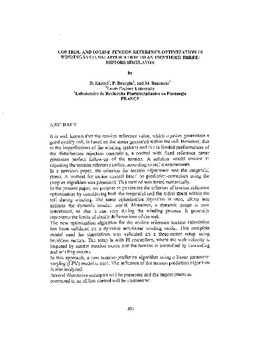| dc.contributor.author | Knittel, D. | |
| dc.contributor.author | Bourgin, P. | |
| dc.contributor.author | Boutaous, M. | |
| dc.contributor.other | International Conference on Web Handling (2005) | |
| dc.date.accessioned | 2019-11-08T22:56:50Z | |
| dc.date.available | 2019-11-08T22:56:50Z | |
| dc.date.issued | 2005-06 | |
| dc.identifier | oksd_icwh_2005_knittel | |
| dc.identifier.citation | Knittel, D., Bourgin, P., & Boutaous, M. (2005, June). Control and online tension reference optimization in winding systems: Application to an identified three-motors simulator. Paper presented at the Eighth International Conference on Web Handling (IWEB), Stillwater, OK. | |
| dc.identifier.uri | https://hdl.handle.net/11244/321882 | |
| dc.description.abstract | It is well known that the tension reference value, which a priori guarantees a good quality roll, is based on the stress generated within the roll. However, due to the imperfections of the winding systems and to the limited performances of the disturbances rejection controllers, a control with fixed reference never generates perfect follow-up of the tension. A solution would consist in adjusting the tension reference online, according to real measurements. | |
| dc.description.abstract | In a previous paper, the criterion for tension adjustment was the tangential stress. A method for online control based on prediction-correction using the simplex algorithm was presented. This method was tested numerically. | |
| dc.description.abstract | In the present paper, we propose to generalize the criterion of tension reference optimization by considering both the tangential and the radial stress within the roll during winding. The same optimization algorithm is used, taking into account the dynamic tension model. Moreover, a dynamic gauge is now introduced, so that it can vary during the winding process. It generally represents the limits of elastic deformations of the web. | |
| dc.description.abstract | The new optimization algorithm for the on-line reference tension calculation has been validated on a dynamic non-linear winding model. This complete model used for simulations was validated on a three-motor setup using brushless motors. The setup is with PI controllers, where the web velocity is imposed by master traction motor and the tension is controlled by unwinding and winding motors. | |
| dc.description.abstract | In this approach, a new tension-prediction algorithm using a linear parameter varying (LPV) model is used. The influence of the tension prediction algorithm is also analyzed. | |
| dc.description.abstract | Several illustrative examples will be presented and the improvement as compared to an offline control will be commented. | |
| dc.format | application/pdf | |
| dc.language | en_US | |
| dc.publisher | Oklahoma State University | |
| dc.rights | In the Oklahoma State University Library's institutional repository this paper is made available through the open access principles and the terms of agreement/consent between the author(s) and the publisher. The permission policy on the use, reproduction or distribution of the article falls under fair use for educational, scholarship, and research purposes. Contact Digital Resources and Discovery Services at lib-dls@okstate.edu or 405-744-9161 for further information. | |
| dc.title | Control and online tension reference optimization in winding systems: Application to an identified three-motors simulator | |
| osu.filename | oksd_icwh_2005_knittel.pdf | |
| dc.type.genre | Conference proceedings | |
| dc.type.material | Text | |
